Physical Address
304 North Cardinal St.
Dorchester Center, MA 02124
The development of techniques to treat complications of infectious lung disease formed the cornerstone of modern thoracic surgery, dominating the specialty until approximately 1960. Although advances in critical care, antibiotic therapy, and other alternative treatments have lessened the impact of many lung infections in the practice of today's cardiothoracic surgeons, current evidence suggests other categories of pulmonary infection are on the rise. There are several reasons for this change: the use of broad-spectrum antimicrobial agents, selecting out resistant organisms; the emergence of new, opportunistic organisms, freshly minted as human pathogens; the widespread application of transplant techniques, accompanied by the ubiquitous immunosuppression protocols; and importantly, the failure of preventive medicine and public hygiene measures to reduce the rate of community-acquired infection. If anything, the infectious challenges facing cardiothoracic surgeons today are more daunting than they were 40 years ago. This chapter reviews the more common causes of pulmonary infection and their treatment.
The term pneumonia refers to infection of the lower respiratory tract, involving the respiratory bronchioles to the distal alveoli. These illnesses have been subclassified based on the mode and timing of presentation and on the existing comorbidities of the affected patient. These distinctions are often useful when considering empiric antibiotic therapy. The terms typical and atypical pneumonias, which refer to the causative organism, are outdated but still occasionally useful when considering this subject. Pneumonias caused by so-called atypical organisms (including Mycoplasma pneumoniae, Legionella species, and Chlamydia pneumoniae ) can comprise up to 40% of cases but are rarely distinguishable from typical bacterial pneumonias at clinical presentation. Thus, the initial therapy chosen should consider both typical and atypical pathogens.
Community-acquired pneumonia (CAP) describes an acute bacterial or viral respiratory infection, contracted outside the confines of the hospital or long-term care facility setting. It remains a common illness, with an estimated incidence of between 5 and 6 million cases resulting in more than 1 million hospitalizations annually. Because CAP is not a reportable illness, these figures likely underestimate the actual magnitude of the problem. The aggregate cost for treating these patients approaches $9 billion a year, most of which is spent on inpatient management. The length of hospitalization has been shown to be the key factor in determining the cost of treatment. Pneumonia remains the eighth leading cause of death in the United States. The mortality rate associated with the development of pneumonia ranges from 1% to 5% for ambulatory patients without comorbidities, to 23% in those hospitalized, and to up to 40% for those requiring intensive care unit (ICU) admission.
The most common pathogens responsible for CAP are listed in Table 12-1 . Streptococcus pneumoniae has remained the most commonly identified organism, followed by Haemophilus influenzae, Staphylococcus aureus, enteric gram-negative bacilli, Legionella species, Mycoplasma pneumoniae, Chlamydia pneumoniae, and respiratory viruses. In up to 50% of cases, a causative organism is not identified. The likelihood of finding a particular pathogen often depends on the population studied (see Table 12-1 ) and the diagnostic tests used. For example, the use of sputum culture favors pneumococcus as the most frequently identified organism, whereas M. pneumoniae is seen more commonly when serologic tests are used. The presence of a “mixed” infection involving atypical and typical organisms can approach 40%, although it is uncertain whether the atypical organisms, when present, represent an actual coinfection, a preceding infection, or simple colonization. However, empiric antibiotic regimens that cover both typical and atypical organisms have been associated with improved survival and shorter hospitalizations in several large retrospective studies.
| Outpatients without Comorbidities * | Outpatients with Comorbidities | Hospitalized Patients without Comorbidities | Hospitalized Patients Requiring ICU Admission |
|---|---|---|---|
| S. pneumoniae | S. pneumoniae | S. pneumoniae | S. pneumoniae |
| M. pneumoniae | M. pneumoniae | H. influenzae | Legionella spp. |
| C. pneumoniae | C. pneumoniae | M. pneumoniae | H. influenzae |
| H. influenzae | Mixed infection † | C. pneumoniae | Enteric gram-negative bacilli |
| Respiratory viruses | H. influenzae | Mixed infection | S. aureus |
| Legionella spp. | Enteric gram-negative bacilli | Enteric gram-negative bacilli | M. pneumoniae |
| M. tuberculosis | Respiratory viruses | Aspiration (anaerobes) | Legionella spp. |
| Endemic fungi | M. catarrhalis | Respiratory viruses | Respiratory viruses |
| Legionella spp. | Legionella spp. | C. pneumoniae | |
| Aspiration (Anaerobes) | M. tuberculosis | M. pneumoniae | |
| M. tuberculosis | Endemic fungi | Endemic fungi | |
| Endemic fungi | P. carinii | P. aeruginosa |
* Chronic obstructive pulmonary disease, congestive heart disease, diabetes mellitus.
† Often a polymicrobial infection of typical and atypical organisms.
Certain risk factors may predispose patients to infection with particular organisms. For example, pneumonia caused by drug-resistant pneumococcus has been associated with advanced age (>65 years), alcoholism, immune-suppressive illness or therapy, recent β-lactam therapy, and other significant comorbidities. Enteric gram-negative infections are seen more frequently in nursing home patients; patients with significant other medical conditions, including cardiopulmonary disease; and patients who have recently undergone antibiotic therapy. Pseudomonal infections are more likely to arise in those with structural lung disease, malnutrition, or in the presence of immune-suppressive or broad-spectrum antibiotic therapy. H. influenzae infections occur more frequently in smokers than in nonsmokers.
Patients with CAP typically present with cough (90%), dyspnea (66%), sputum production (66%), and pleuritic chest pain (50%). Nonrespiratory symptoms such as malaise, headache, nausea, myalgias, arthralgias, abdominal pain, and mental confusion are seen in 10% to 30% of patients. Older adult patients often have fewer or less severe symptoms than younger patients. Presenting signs on physical exam include fever (80%), tachypnea, tachycardia, and a generalized toxic state. Crackles on auscultation are common (80%), with indications of consolidation in up to 30% of patients.
Evaluation with chest radiography should be undertaken in all patients who have symptoms and signs suggestive of pneumonia. Standard posteroanterior and lateral films classically reveal a segmental ( Fig. 12-1 ) or lobar infiltrate, often with evidence of a parapneumonic effusion. Chest films also help distinguish pneumonia from other disorders that may display similar symptoms and can help assess the severity (e.g., multilobar involvement) of the illness. Contributing or causative factors such as bronchial obstruction, lung abscess, or tuberculosis can also be seen. The addition of computed tomography may occasionally be helpful in difficult cases, but few data are available to support its routine use in the initial evaluation of patients with CAP.
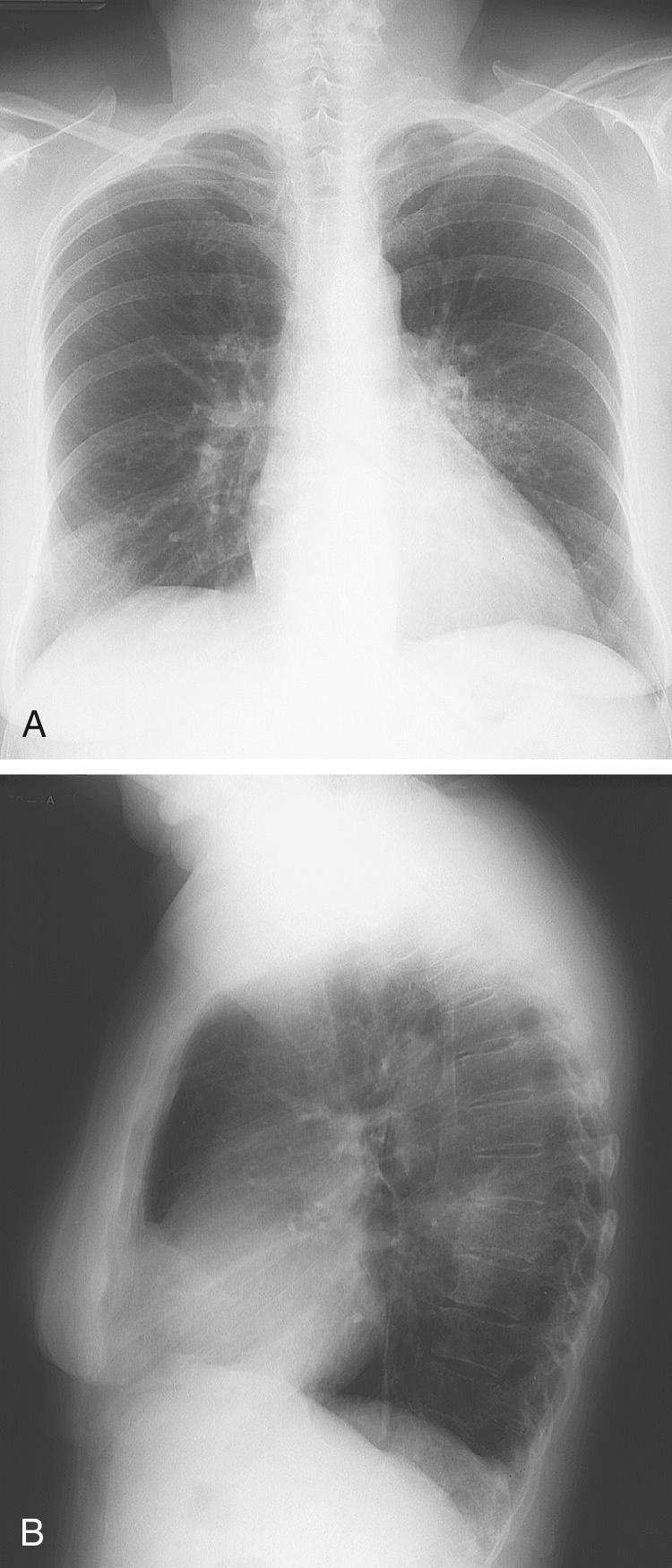
Routine collection of laboratory studies in ambulatory patients is rarely necessary but may occasionally steer clinicians toward hospital admission in equivocal cases. Laboratory studies in hospitalized patients should include complete blood count, electrolytes and glucose, renal and liver function tests, and assessment of oxygen saturation. Patients aged 15 to 54 should undergo human immunodeficiency virus (HIV) testing with informed consent. Tests used to identify a causative agent (including blood cultures and sputum Gram stain and culture) should be performed in all patients admitted with pneumonia, although some have questioned the usefulness of blood cultures in low-risk patients. Viral cultures have not been shown to be useful in the initial evaluation of patients with CAP and should not be routinely performed, although clear improvement in the diagnostic yield has been demonstrated with the use of real-time polymerase chain reaction (PCR) analysis. Every attempt should be made to obtain these cultures before initiating therapy but not at the expense of unnecessary delays in treatment. Culture data should be correlated with the Gram stain result before narrowing antibiotic therapy. Significant pleural effusions should be tapped and sent for laboratory and culture studies. Routine serologic and cold agglutinin testing is generally not recommended in the initial evaluation of patients with CAP but may prove useful in select cases. This recommendation is based on the low failure rate seen with empiric therapy for patients treated in the outpatient setting. A pneumococcal urinary antigen assay approved by the U.S. Food and Drug Administration can be used to augment the standard diagnostic methods, with the advantage of rapid results similar to the Gram stain. Sensitivity and specificity rates of 80% to 90% have been reported. Use of similar technology to detect pneumococcal antigen in sputum has also been reported.
Patients with pneumonia caused by Mycoplasma species often show signs and symptoms reminiscent of a mild viral illness, with a more gradual onset and less intense nature. These infections, as with other “atypical” infections, occur more frequently in younger patients. Headache, malaise, sore throat, low-grade fever, and rhinorrhea are common. Cough, when present, is frequently nonproductive and spasmodic in character. Extrapulmonary manifestations may predominate, with rash, arthralgias, and neurologic abnormalities present. The physical exam of the chest may yield minimal findings, although a wheeze and crackles can sometimes be appreciated. Radiologic findings include nodular or peribronchial infiltrates, an interstitial pattern of disease ( Fig. 12-2 ), and occasional consolidation. Pleural effusions occur frequently. Although the white cell count is often normal, anemia can be seen as a result of hemolytic anemia associated with a positive Coomb test result. Serologic diagnosis can be obtained through measurement of immunoglobulin M (IgM) or immunoglobulin G (IgG) titer using a complement fixation test.
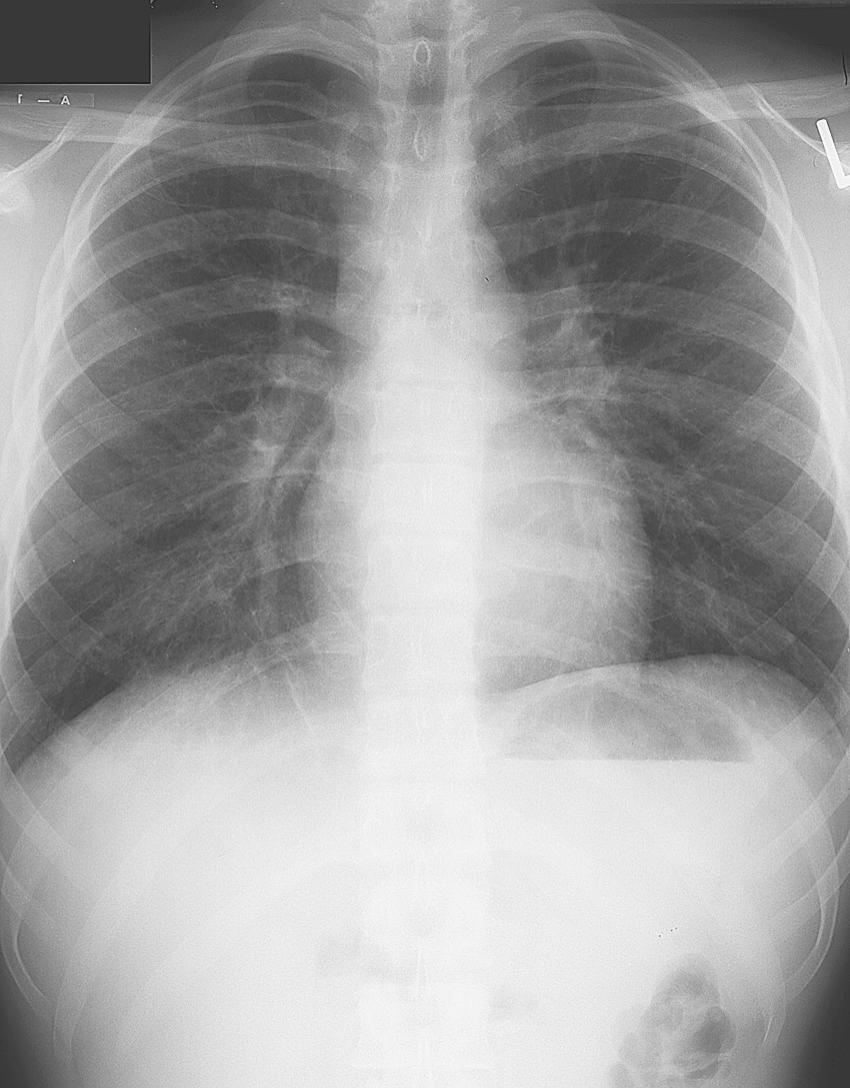
Pneumonia caused by Legionella (Legionella pneumophila) remains problematic since the initial recognized outbreak of the disease at an American Legion convention in Philadelphia in 1976. The organism is identified in 1% to 5% of patients hospitalized with pneumonia, with considerable variation in detection as a result of geographic patterns and difficulties in accurate diagnosis. Culture may still be the best way of identifying Legionella, along with a urinary antigen assay. However, the latter test can remain positive months after the acute infection. Symptoms suggestive of pneumonia predominate (high fever, chills, dyspnea, cough), but extrapulmonary manifestations (gastrointestinal complaints, malaise, myalgias) are not uncommon. Radiographs usually reveal patchy or diffuse interstitial infiltrates and occasionally consolidation ( Fig. 12-3 ).
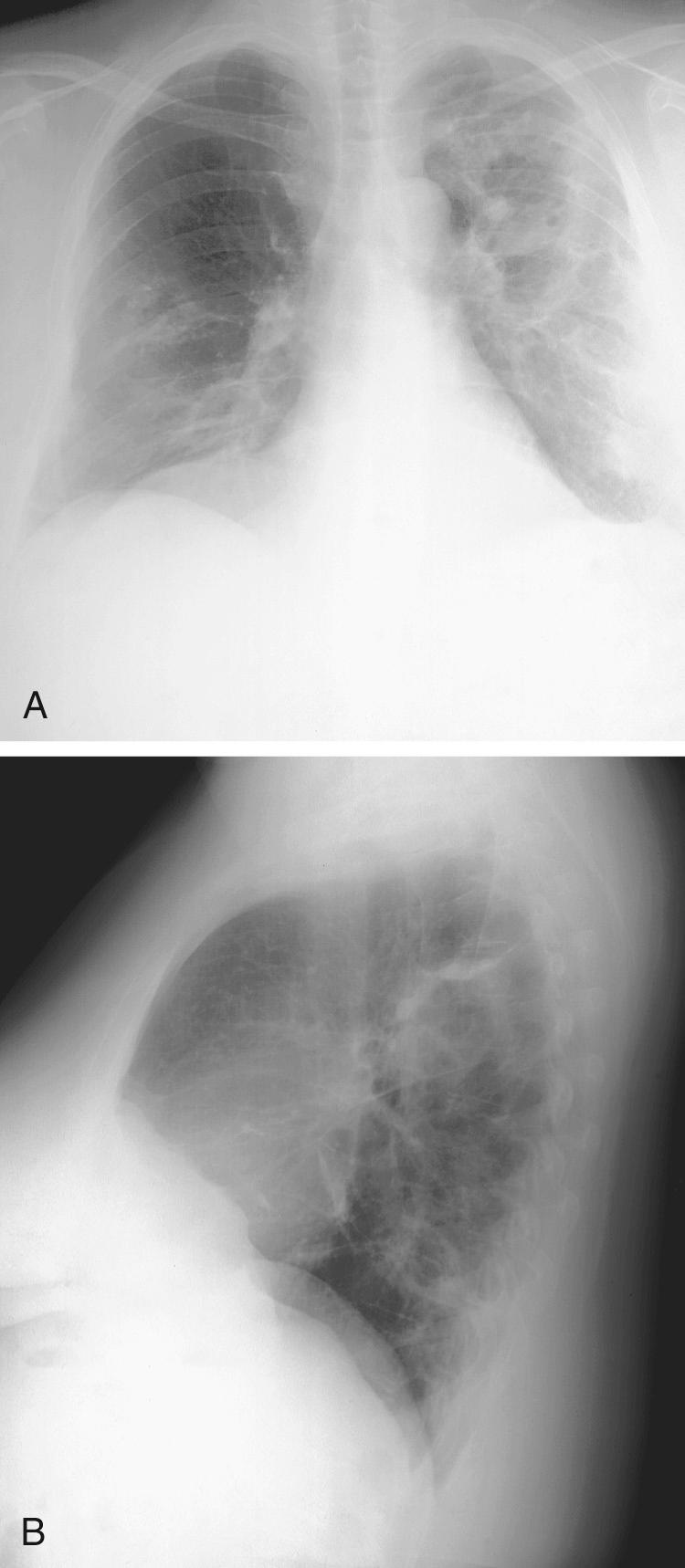
Pulmonary infection with Chlamydia organisms such as C. pneumoniae present in similar fashion to other atypical pneumonias. Infection with this organism has also been associated with chronic diseases such as atherosclerotic coronary disease. Diagnostic tests used to identify this organism include direct tissue culture (sputum smear and culture are not helpful) and display of a fourfold increase in IgG titer or a IgM titer of 1:16 or higher using a microimmunofluorescence test.
One of the key decisions made in the initial evaluation of CAP, beyond establishing a presumptive diagnosis, pertains to the need for inpatient therapy. Many of the patients afflicted with CAP are older adults with significant comorbidities for whom the progressive pulmonary infection is clearly life-threatening. On the other hand, improper admission for CAP therapy taxes the health care system billions of dollars annually. In the United States, less than 20% of patients with CAP are admitted for inpatient therapy, but these patients account for more than 90% of the costs related to the disease treatment. As a result, various guidelines have been developed to assist clinicians in the assessment of severity of illness at presentation. One such system, termed the Pneumonia Severity Index (PSI), was validated with data from approximately 2300 patients in the Pneumonia Patient Outcomes Research Team (PORT) cohort study. Based on clinical parameters obtained at initial presentation, a risk score or class is determined ( Fig. 12-4 ). Patients with a risk class of I, II, or III had a low mortality rate (<1%) and were considered to be at low risk, thus amenable to outpatient management. Patients with a risk class of IV or V were associated with higher mortality rates (9.3 and 27.0, respectfully) and were considered to be appropriate candidates for hospitalization. The value of the PSI has since been confirmed in multiple studies, and the PSI is endorsed within the guidelines set forth by the American Thoracic Society and Infectious Diseases Society of America. These guidelines emphasize a multistep process in determining the initial site of treatment, based on (1) assessment of factors that compromise the safety of home care, (2) the PSI score, and (3) clinical judgment. The PSI has been criticized, however, because of the relative complexity of the assessment required.
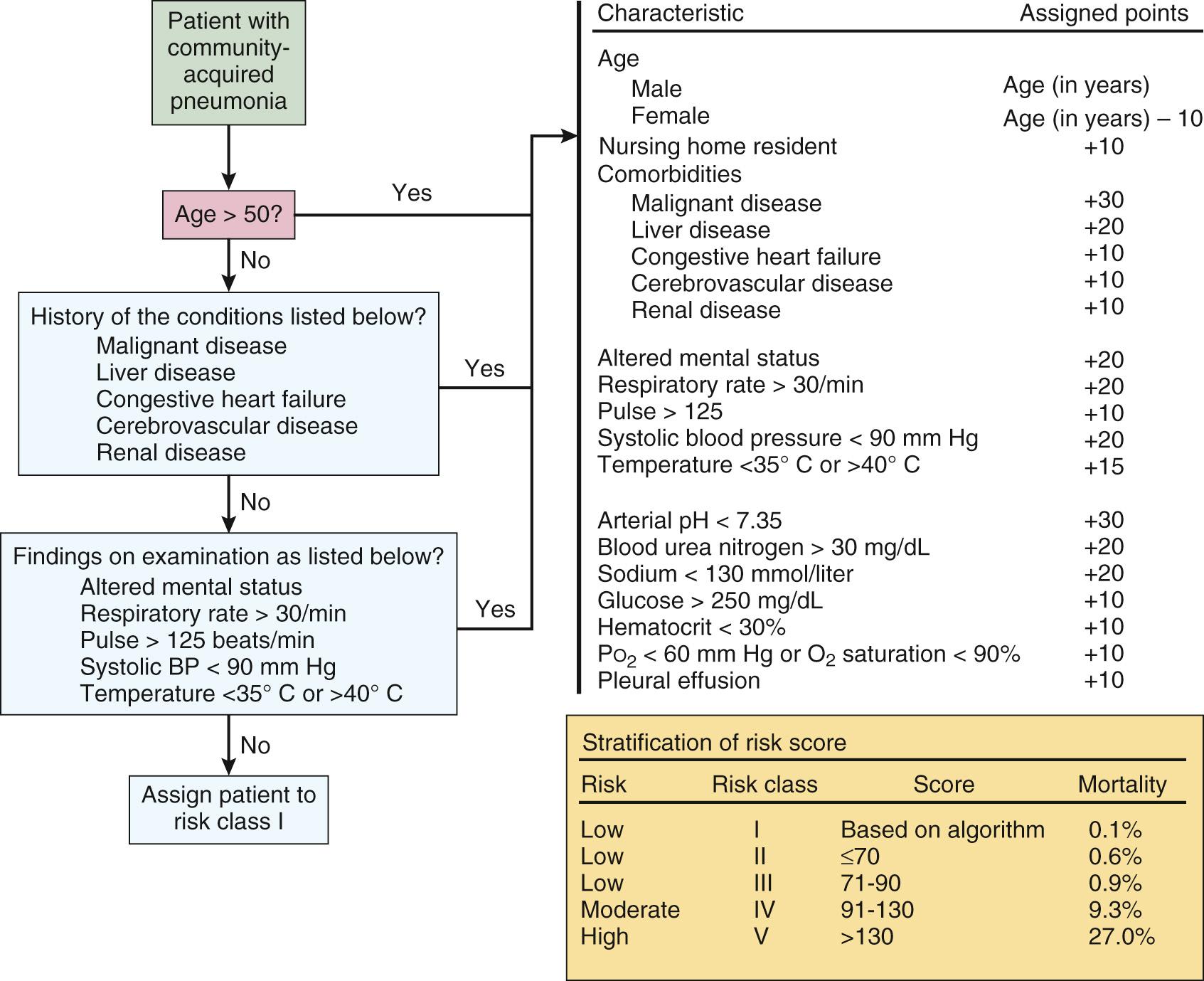
In contrast, the British Thoracic Society has adopted an alternative prediction rule for risk stratification in the setting of CAP, termed CURB-65 . The CURB-65 uses five prognostic variables: the presence of c onfusion, a blood u rea nitrogen concentration (BUN > 20 mg/dL), r espiratory rate (>30 breaths/min), low b lood pressure (systolic, <90 mm Hg; diastolic, <60 mm Hg), and age (> 65 years). Patients with scores of 0 or 1 were considered to be appropriate for outpatient care; those with scores of 2 or 3 should be considered for admission, perhaps to the ICU; and scores of 4 or 5 should receive mandated ICU care. A simplified version of CURB-65, termed CRB-65, drops the use of the BUN measurement and thus is applicable to the outpatient office setting.
The PSI and the CURB-65 have been compared in a variety of studies, with strengths and weaknesses described for both systems. The PSI is particularly good at identifying patients with a low risk of mortality, but it tends to underestimate severity of illness in some patient populations. Alternatively, the CURB-65 more accurately identifies those patients with severe CAP and at high risk of death. It has been proposed that the two assessment tools may be thought of as complementary rather than competitive tests.
The treatment for CAP at initial presentation is outlined in Figure 12-5 , as described by the American Thoracic Society and Infectious Diseases Society of America, stratified by the presence or absence of modifying factors, comorbidities, and site of initial treatment. Data from published reports support the use of the published guidelines, leading to better outcomes. It should be reinforced that the timing of therapy is important, with the first dose of antibiotic given 4 to 8 hours after initial presentation. Prompt administration of therapy has been associated with improved survival. The use of the published guidelines facilitates prompt delivery of appropriate therapy. Furthermore, although it is desirable to narrow the spectrum of administered antibiotic agents, this is not possible in up to 50% of cases because the causative organism has not been identified. In addition, a significant proportion of cases represent mixed polymicrobial infections. The use of these guidelines using broad-spectrum therapy allows for appropriate treatment in these patients.
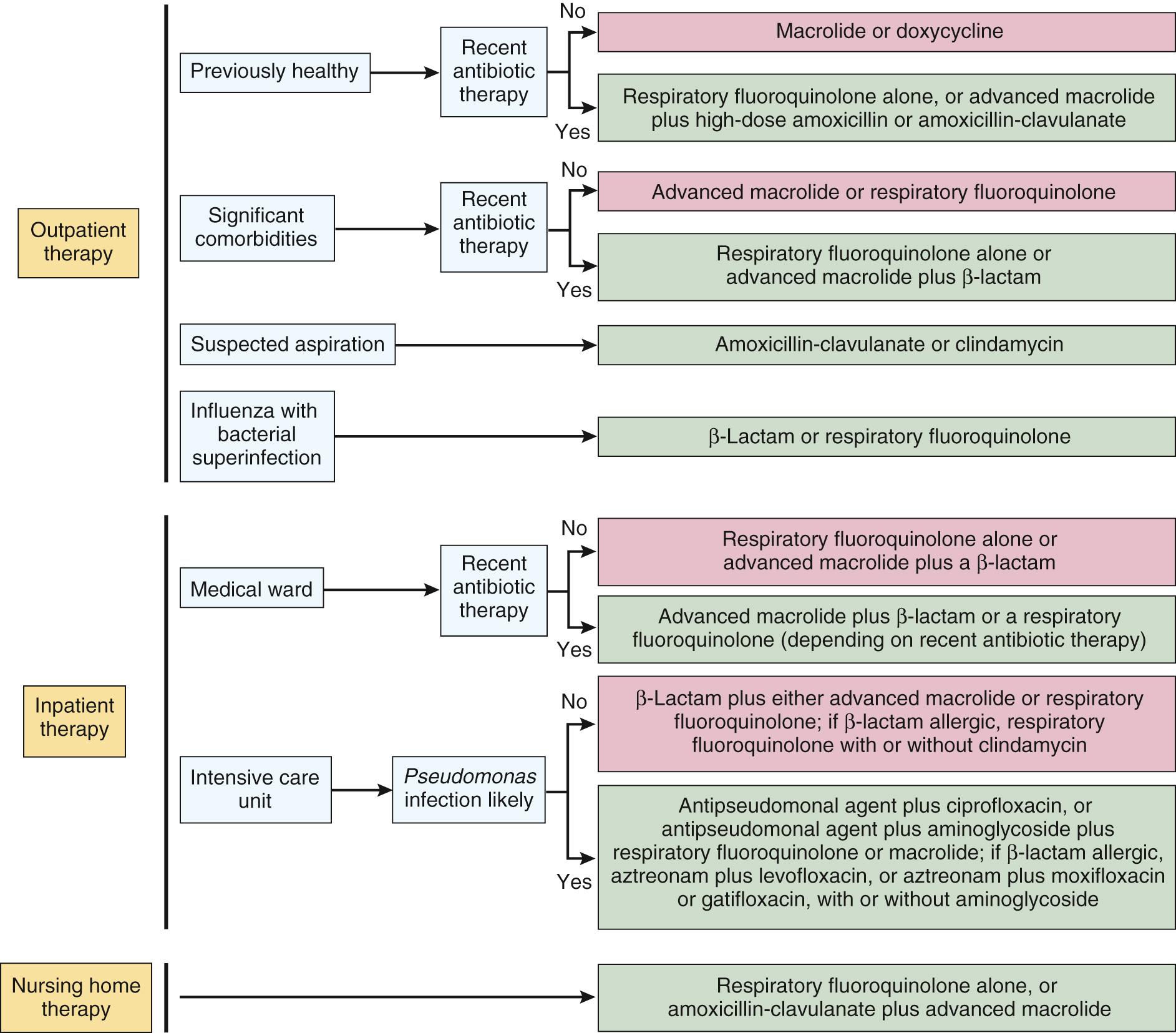
Clinical decisions regarding duration of therapy are poorly supported in the literature. In general, most treatment regimens last 7 to 14 days; the severity of the presenting illness, the response to therapy, and the underlying comorbidities should all be considered when addressing duration of treatment. Most bacterial infections, including those caused by S. pneumoniae, are treated for 7 to 10 days provided a good clinical response is seen. Mycoplasma, Chlamydia, and Legionella infections should be treated for 10 to 14 days, and perhaps longer if significant comorbidity exists.
Successful response to therapy in a patient with CAP usually follows a predictable course. Stabilization of clinical parameters often occurs by 72 hours, with gradual improvement noted thereafter. The severity of the presenting illness and underlying patient disease understandably play a role in the response to therapy. The febrile response and leukocytosis typically resolve by day 4 or 5, with the radiologic findings lagging behind. In fact, the initial radiographic abnormalities may worsen before improvement is documented. Only 15% of chest films are clear at discharge, and many cases take 2 to 3 months to return to normal. With a successful response to treatment, consideration should be given to conversion to oral therapy. The American Thoracic Society describes four criteria that should be met prior to switching to oral therapy: improvement in cough and dyspnea; afebrile (<100° F) at two consecutive assessments 8 hours apart; resolving leukocytosis; and a functioning gastrointestinal tract with oral intake. Obviously, some leeway may be allowed in these criteria given the clinical situation. Compliance can be an issue with oral therapy, and consideration of drug dosing schedules and side effects should be taken into account when selecting an oral regimen.
Two adjunctive therapies have been studied for their effects on outcome in patients with severe CAP. In a retrospective analysis, the administration of activated protein C to a subset of patients in the PROWESS study with CAP was associated with a drop in mortality rates. Further studies, including prospective randomized trials, remain pending. In at least one randomized study, the use of a continuous infusion of corticosteroids in patients with CAP was associated with lower mortality rates, shorter length of ICU stay, and shorter duration of mechanical ventilation. No increase in complications was associated with the use of steroids in this patient population.
Two serum markers, C-reactive protein (CRP) and procalcitonin (PCT), have been studied to assess response to CAP therapy, determine outcome, and guide duration of therapy. Of the two, PCT seems the most promising. PCT is the precursor to calcitonin and has no hormonal effects. Serum levels of PCT rise in the setting of acute bacterial infections, stimulated by cytokines, microbial toxins, and the cell-mediated immune response. One study determined that higher serum levels of PCT, drawn within 24 hours of admission to hospital, were associated with higher PSI levels and a greater risk of mortality. Other investigators have found PCT levels useful in predicting outcome and guiding duration of therapy.
Clinicians should resist the urge to switch antibiotic therapy within the first 72 hours, unless marked clinical deterioration occurs. Failure to respond to initial therapy occurs in up to 10% of patients because of a variety of factors. The presence of a drug-resistant or unusual pathogen may be the cause, which may be remedied by further diagnostic tests for the causative agent, broadening the antibiotic therapy, or both. A complication of the initial pneumonia may be present, at either a local (e.g., lung abscess, empyema) or a distant (e.g., meningitis, endocarditis, septic arthritis) site. Selected imaging, such as computed tomography and echocardiography, as well as sampling of fluid collections based on these studies and physical exam, can often reveal the source of the persistent infection. Finally, several noninfectious illnesses can mimic pneumonia and should be ruled out. This group of disease states is extensive and includes bronchogenic cancer, lymphoma, and a variety of inflammatory and interstitial lung diseases.
Hospital-acquired pneumonia (HAP) refers to pulmonary infection that occurs after at least 48 to 72 hours of admission to an acute care facility or in intubated patients. The latter situation is termed ventilator-associated pneumonia . HAP is the second most common nosocomial infection and has the highest mortality , with crude mortality rates of 30% previously reported. Risk factors for nosocomial pneumonia have been described and include the extremes of age, chronic lung disease, previous abdominal or thoracic surgery, endotracheal intubation, and duration of mechanical ventilation.
Two factors predispose patients to nosocomial pneumonia: the aerodigestive tract is colonized with bacteria, and the contaminated secretions are aspirated into the lower respiratory system. Several of the preventive strategies described later are aimed at interrupting these two processes.
Ventilator-associated pneumonia (VAP) is a nosocomial pulmonary infection that develops in patients receiving mechanical ventilation. VAP that occurs early, within 48 to 72 hours after intubation, is typically caused by bacteria responsive to antibiotic therapy (e.g., pansensitive S. aureus, H. influenzae, and S. pneumoniae ) and frequently results from aspiration complicating the intubation process. In contrast, late-onset VAP is often caused by antibiotic-resistant organisms (e.g., methicillin-resistant S. aureus [MRSA], Pseudomonas aeruginosa, Acinetobacter and Enterobacter species). Risk factors for VAP include the duration of mechanical ventilation, age older than 70 years, H 2 or antacid therapy, chronic lung disease, depressed consciousness, need for reintubation, and gastric aspiration. The incidence of VAP is significantly higher in surgical ICUs as opposed to medical ICUs, according to the Centers for Disease Control and Prevention.
There is some controversy in the literature regarding optimal diagnosis of VAP. To date, there seems to be little evidence supporting the use of invasive (bronchoscopic) techniques for diagnosis compared with quantitative tracheobronchial aspirates, with no difference in subsequent mortality, length of hospital stay, or duration of mechanical ventilation. Bronchoscopy may be of use in patients who fail to respond to initial therapy. The treatment of VAP consists of general supportive care and the administration of empiric broad-spectrum antibiotics, guided by the severity of the illness. The adequacy of initial antibiotic therapy appears to be the most important determinant of outcome. Numerous studies have examined preventive measures to limit the development of VAP. The use of semi-recumbent positioning, sucralfate instead of H 2 antagonists for stress ulcer prophylaxis, and selective digestive tract decontamination has the strongest support in the literature.
Health care–associated pneumonia (HCAP) refers to pneumonia that occurs in a nonhospitalized patient with extensive health care contacts. Examples of such contacts include outpatient intravenous therapy, hospitalization, or treatment at a hospital or dialysis unit within the past 30 days; or residence in a nursing home or other long-term care facility. In general, the recommendations for treatment mirror those suggested for HAP.
Become a Clinical Tree membership for Full access and enjoy Unlimited articles
If you are a member. Log in here